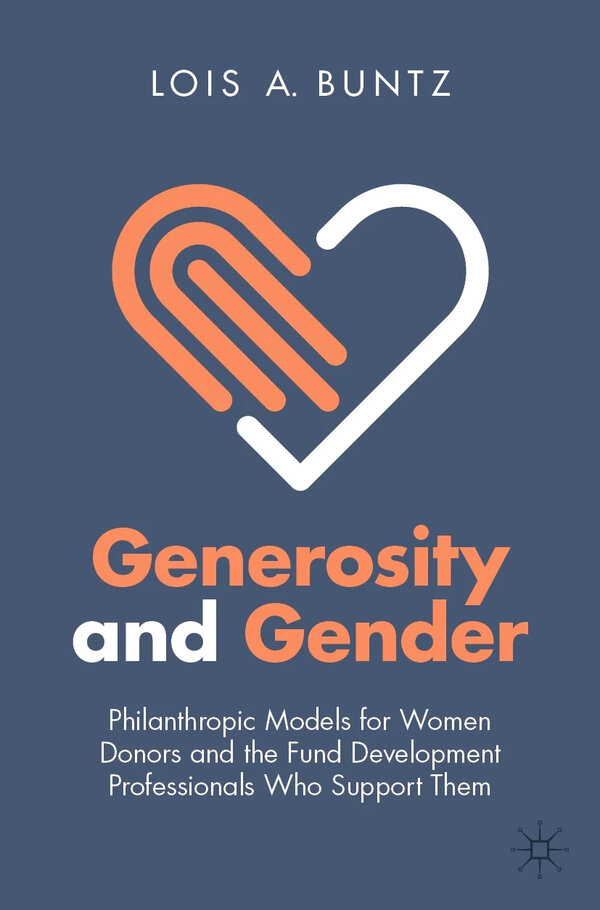Generosity and Gender: Philanthropic Models for Women Donors and the Fund Development Professionals Who Support Them
The COVID-19 pandemic has impacted how fundraisers work—forcing the social sector to reexamine, adapt, and create new methods to reach donors and it is also time, Lois A. Buntz suggests, to focus on and better engage women donors.
In her book Generosity and Gender: Philanthropic Models for Women Donors and the Fund Development Professionals Who Support Them, Buntz analyzes how women practice philanthropy and how fundraisers can more effectively inspire their work. She selected the keywords “generosity” and “gender,” to emphasize the “expansiveness and variety of giving” that can occur “through everyday encounters, random acts of kindness, or ways that people enact their beliefs and values in social interactions”—as distinct from “philanthropy”—and to remind “fundraisers to broaden their conversations and practice inclusion, diversity and equity in all their work.” A former CEO of United Way of East Central Iowa who now provides strategic planning and fund development services and helps develop and implement women’s philanthropy initiatives, Buntz defines women’s philanthropy as “purposeful generosity within the context of formal and informal networks.”
The book explores research findings about women’s motivations for and patterns in giving (how women translate their thoughts and ideas into action)—which emphasize connecting with others, telling their stories, working collaboratively, aligning their interests and values with the causes they support, and influencing the next generation—and their implications for fundraisers, including better ways to combine objective analysis and subjective reasoning and using various tools and assessment instruments to determine the best prospects. Each chapter describes the author’s research, cites interviews and real-world examples, and ends with suggestions for fundraisers.
The centerpiece of the book is a six-step model that Buntz has used in her fund development work: Awareness, Assessment, Alignment, Action, Acknowledgement, and Achievement. Buntz begins by highlighting examples of female philanthropists, then describes how “awareness built social movements” during the three historical waves of women’s philanthropy and “how building awareness of women’s needs, concerns, and challenges can engage women as supporters, advocates, prospects, and donors.” She also provides a “continuum of awareness” chart to help fundraisers assess where prospective women donors are.
Next, in “assessing women’s wealth origins, an organization’s ability to develop a women’s philanthropy initiative and aligning women’s philanthropic interests and values with their wealth capacities,” she looks at how women who come into their fortunes through inheritance, marriage, and earned income each give differently. Buntz goes on to argue that any organization, regardless of size, can build a women’s philanthropy initiative; therefore, the charity should conduct an assessment (what to ask, who to ask, how to ask) using Systems Theory to determine whether it is sufficiently prepared to launch a women’s philanthropy initiative. She advises fundraisers to be patient and research “two key strategies for alignment: identification of a donor’s value and understanding her wealth capacity,” so they can help donors find their passion and make giving “a joyful and memorable experience.”
Once the charity has secured those fundamentals, it’s time to take the actions necessary to make it happen. Buntz first considers several women’s philanthropy initiatives in different stages of development, providing insight on what is possible and successful. The initiatives vary in scope and size (integrated into existing foundations or independent or connected with other partners). In the next step, Buntz further points out the differences between women’s philanthropy initiatives and the traditional organizational framework. While “assessing and evaluating success is usually limited to grant making and the outcome of investments,” she calls for an evaluation of the organization itself, which is “about learning and improving.” In making the “ask,” she writes, “[a] well-prepared plan usually ensures better results, but it’s even more important to remember that ‘an ask’ is about creating a joyful and memorable experience, generating happiness and ideally connecting the donor to something self-fulfilling, meaningful and purposeful.” She explains how to think about the goal (purpose and money) and the process (preparation and planning) and suggests setting up a meeting to better sell the concept or cause to the donor. It is also essential to follow up with a letter within 24 to 48 hours thanking them for their time and clarifying any decisions. A debrief may also be needed to discuss with co-workers what did and did not work during the ask.
The need to show gratitude and offer acknowledgement may seem obvious but is essential when engaging women: “Thanking people and demonstrating gratitude is an expression of good social graces, but more importantly it connects the giver and receiver in a special bond.” According to the book, it’s a good practice for the fundraiser to contact the donor two or three times before asking for money. “Women are information seekers,” writes Buntz. “They investigate causes before they contribute, ask questions, seek advice and want to be educated. When it comes to being thanked for their contributions, women want to know the impact of their gift, especially how it relates to their personal connection.”
In the achievements stage—“a goal constantly hovering on the horizon, it is not the finale, but rather a milestone in the continuous evolution of an initiative”—the author highlights three sectors that have embraced “women’s philanthropy with unique and creative approaches yielding successful outcomes and achievements”: health care, higher education, and the environment. Buntz also illustrates the need for investments in women’s leadership development, entrepreneurial ventures, and career advancement. It is often difficult for women-led business to secure funding because “women don’t promise the moon to investors or expound on aspirational possibilities” as men do. Moreover, women are treated differently by investors, she notes. “This is particularly evident in an analysis of how investors view entrepreneurs making their ‘pitch’ for investing funding.” To address that gap, Buntz argues, leadership training programs and promotions of women on corporate boards are needed to help advance women as influencers in the business sector.
The book also explores several emerging trends, including impact and gender-lens investing, LLCs as alternatives to family foundations. Strategies for women’s philanthropy initiatives need to include data, structure, and emotion, Buntz advises, for women have a desire to help others, make connections, and improve their community; they also want answers about the organization’s structure and how it intersects with their interests. She also recommends incorporating into strategy and structure the five steps of Human-Centered Design, which focuses on understanding the perspective of the person experiencing the problem and involving them in creating solutions: empathize, define, ideate, prototype, and test and iterate.
Moreover, there is an urgent need to engage a broader range of philanthropists, particularly women of color and younger donors. National foundation leaders, women philanthropists, and women of color share insights and strategies about working with this population and how to adapt traditional fundraising methods.
Buntz closes with a series of calls to action: She calls on fundraisers and organizations to host learning opportunities about women’s philanthropy, including how to engage a diverse group of donors. She calls on the broader philanthropic community to recognize the contributions of women philanthropists, commit to continue learning about women’s philanthropy and enabling experts to share their knowledge and research, make room for new partners who haven’t been an integral part of the conversation and fully invest in their ideas about change, and implement diversity, equity, and inclusion policies and practices, both in its grantmaking and internal operations, such as applying a gender lens and making impact investments, and providing women fundraisers with career advancement opportunities and protecting them from harassment. And finally, she suggests that women donors assess their financial situation and capacity, prioritize their values and interests, engage with friends and/or family, and take control of their own philanthropy and create a legacy.
The book provides insightful analyses of the role women philanthropists have played, how women give, and how women’s philanthropy initiatives can better engage them. Based on extensive interviews, the book is full of compelling examples and anecdotes about specific women’s experiences—which at times can also feel overwhelming. Much like the women she describes as “netweavers” rather than “networkers” (quoting marketing consultant Bob Little), Buntz offers a rich tapestry of examples to hang on her six-step model for fund development and guides professionals and women donors in thinking and learning about women’s philanthropy.
Yue Wang is a software engineer at Candid.







